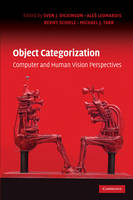
Object Categorization
Cambridge University Press (Verlag)
978-0-521-88738-0 (ISBN)
This edited volume presents a unique multidisciplinary perspective on the problem of visual object categorization. The result of a series of four highly successful workshops on the topic, the book gathers many of the most distinguished researchers from both computer and human vision to reflect on their experience, identify open problems, and foster a cross-disciplinary discussion with the idea that parallel problems and solutions have arisen in both domains. Twenty-seven of these workshop speakers have contributed chapters, including fourteen from computer vision and thirteen from human vision. Their contributions range from broad perspectives on the problem to more specific approaches, collectively providing important historical context, identifying the major challenges, and presenting recent research results. This multidisciplinary collection is the first of its kind on the topic of object categorization, providing an outstanding context for graduate students and researchers in both computer and human vision.
Sven Dickinson is Professor of Computer Science at the University of Toronto. From 1994 until 2000, he was Assistant Professor at Rutgers University, where he held joint appointments in the Department of Computer Science and the Rutgers Center for Cognitive Science. He was co-chair of the 1997, 1999, 2004, and 2007 IEEE International Workshops on Generic Object Recognition and Categorization and co-chair of the First International Workshop on Shape Perception in Human and Computer Vision in 2008. Aleš Leonardis is a Professor and Head of the Visual Cognitive Systems Laboratory at University of Ljubljana and Adjunct Professor at the Faculty of Computer Science, Graz University of Technology. He was a researcher and visiting professor at University of Pennsylvania, Vienna University of Technology, Swiss Federal Institute of Technology, and University of Erlangen. Bernt Schiele is Professor of Computer Science at TU Darmstadt, Germany. He obtained his Ph.D. from INPG in Grenoble, France. He was researcher at Carnegie Mellon University and visiting Assistant Professor at Massachusetts Institute of Technology, as well as Assistant Professor at the Swiss Federal Institute of Technology in Zurich (ETH Zurich). Michael J. Tarr is the Fox Professor of Ophthalmology and Visual Sciences, a Professor of Cognitive and Linguistic Sciences, and the co-director of the Center for Vision Research at Brown University. From 1989 to 1995 he was an Assistant Professor of Psychology and Computer Science at Yale University.
1. The evolution of object categorization and the challenge of image abstraction Sven Dickinson; 2. Can we understand how the brain solves object recognition James J. DiCarlo; 3. Visual recognition: where do we come from? What are we doing? Where should we go? Pietro Perona; 4. On what it means to see, and what we can do about it Shimon Edelman; 5. Generic object recognition: the case for high level 3-D features Gerard Medioni; 6. Functional organization and development of the human ventral stream Kalanit Grill-Spector; 7. Reasoning about functionality: object recognition and related developments Kevin Bowyer, Melanie Sutton and Louise Stark; 8. The user-interface theory of perception: perception and categorization in the context of evolution Donald Hoffman; 9. Digital images in large collections or on the web often appear near text D. A. Forsyth, Tamara Berg, Cecilia Ovesdotter Alm, Ali Farhadi, Julia Hockenmaier, Nicolas Loeff and Gang Wang; 10. Structural representation of object shape in the brain Charles Connor; 11. Learning hierarchical compositional representations of object structure Sanja Fidler, Marko Boben and Ales Leonardis; 12. Object categorization in man, monkey, and machine: some answers and some open questions Maximilian Riesenhuber; 13. Learning object category modeling, learning, and recognition by stochastic grammar Jake Porway, Benjamin Yao and Song Chun Zhu; 14. The neurophysiology and computational mechanisms of object representation Edmund Rolls; 15. Recognizing visual classes and individual objects by semantic hierarchies Shimon Ullman; 16. Early stages of object categorization Pawan Sinha, Benjamin Balas, Yuri Ostrovsky and Jonas Wulff; 17. Towards integration of different paradigms in modeling, representation and learning of visual categories Mario Fritz and Bernt Schiele; 18. Acquisition and breakdown of category-specificity in the ventral visual stream K. Suzanne Scherf, Marlene Behrmann and Kate Humphreys; 19. Using simple features and relations Marius Leordeanu, Martial Hebert and Rahul Sukthankar; 20. The proactive brain: using memory to anticipate what's next Kestutis Kveraga, Jasmine Boshyan and Moshe Bar; 21. Spatial pyramid matching Svetlana Lazebnik, Cordelia Schmid and Jean Ponce; 22. Perceptual decisions and visual learning in the human brain Zoe Kourtzi; 23. Shapes and shock graphs: from segmented shapes to shapes embedded in images Benjamin Kimia; 24. Correlated structures in natural scenes and their implications on neural learning of prior models for objects and surfaces Tai Sing Lee, Tom Stepleton, Brian Potetz and Jason Samonds; 25. Medial models for recognition Kaleem Siddiqi and Stephen Pizer; 26. Multimodal categorization C. Wallraven and Heinrich Bulthoff; 27. Comparing images of 3-D objects David W. Jacobs.
| Erscheint lt. Verlag | 7.9.2009 |
|---|---|
| Zusatzinfo | 11 Tables, unspecified; 58 Halftones, unspecified; 46 Line drawings, unspecified |
| Verlagsort | Cambridge |
| Sprache | englisch |
| Maße | 72 x 103 mm |
| Gewicht | 1400 g |
| Themenwelt | Informatik ► Grafik / Design ► Digitale Bildverarbeitung |
| Informatik ► Theorie / Studium ► Künstliche Intelligenz / Robotik | |
| ISBN-10 | 0-521-88738-0 / 0521887380 |
| ISBN-13 | 978-0-521-88738-0 / 9780521887380 |
| Zustand | Neuware |
| Haben Sie eine Frage zum Produkt? |
aus dem Bereich


